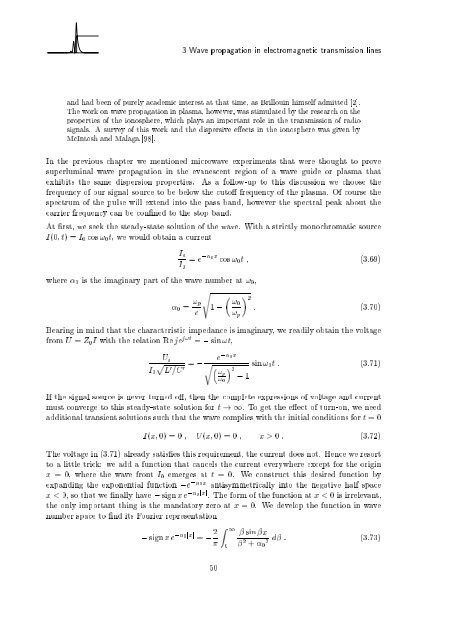Wave Propagation in Linear Media | re-examined
Wave Propagation in Linear Media | re-examined
Wave Propagation in Linear Media | re-examined
You also want an ePaper? Increase the reach of your titles
YUMPU automatically turns print PDFs into web optimized ePapers that Google loves.
3<strong>Wave</strong> propagation <strong>in</strong> electromagnetic transmission l<strong>in</strong>es<br />
and had been of pu<strong>re</strong>ly academic <strong>in</strong>te<strong>re</strong>st at that time, as Brillou<strong>in</strong> himself admitted [2].<br />
The work on wave propagation <strong>in</strong> plasma, however, was stimulated by the <strong>re</strong>search on the<br />
properties of the ionosphe<strong>re</strong>, which plays an important role <strong>in</strong> the transmission of radio<br />
signals. A survey of this work and the dispersive e ects <strong>in</strong> the ionosphe<strong>re</strong> was given by<br />
McIntosh and Malaga [98].<br />
In the p<strong>re</strong>vious chapter we mentioned microwave experiments that we<strong>re</strong> thought to prove<br />
superlum<strong>in</strong>al wave propagation <strong>in</strong> the evanescent <strong>re</strong>gion of a wave guide or plasma that<br />
exhibits the same dispersion properties. As a follow-up to this discussion we choose the<br />
f<strong>re</strong>quency of our signal source to be below the cuto f<strong>re</strong>quency of the plasma. Of course the<br />
spectrum of the pulse will extend <strong>in</strong>to the pass band, however the spectral peak about the<br />
carrier f<strong>re</strong>quency can be con ned to the stop band.<br />
At rst, we seek the steady-state solution of the wave. With a strictly monochromatic source<br />
I(0;t)=I0cos !0t, wewould obta<strong>in</strong> a cur<strong>re</strong>nt<br />
whe<strong>re</strong> 0 is the imag<strong>in</strong>ary part of the wave number at !0,<br />
Is<br />
I0<br />
0 = !p<br />
c<br />
= e , 0x cos !0t ; (3.69)<br />
s<br />
1 , !0<br />
!p<br />
2<br />
: (3.70)<br />
Bear<strong>in</strong>g <strong>in</strong> m<strong>in</strong>d that the characteristic impedance is imag<strong>in</strong>ary, we <strong>re</strong>adily obta<strong>in</strong> the voltage<br />
from U = Z0I with the <strong>re</strong>lation Re je j!t = , s<strong>in</strong> !t,<br />
Us p<br />
I0 L0 =C0 = ,<br />
e , 0x<br />
r<br />
2<br />
!p<br />
!0<br />
, 1<br />
s<strong>in</strong> !0t : (3.71)<br />
If the signal source is never turned o , then the complete exp<strong>re</strong>ssions of voltage and cur<strong>re</strong>nt<br />
must converge to this steady-state solution for t !1. To get the e ect of turn-on, we need<br />
additional transient solutions such that the wave complies with the <strong>in</strong>itial conditions for t =0<br />
I(x; 0) = 0 ; U(x; 0) = 0 ; x>0: (3.72)<br />
The voltage <strong>in</strong> (3.71) al<strong>re</strong>ady satis es this <strong>re</strong>qui<strong>re</strong>ment, the cur<strong>re</strong>nt does not. Hence we <strong>re</strong>sort<br />
to a little trick: we add a function that cancels the cur<strong>re</strong>nt everywhe<strong>re</strong> except for the orig<strong>in</strong><br />
x = 0, whe<strong>re</strong> the wave front I0 emerges at t = 0. We construct this desi<strong>re</strong>d function by<br />
expand<strong>in</strong>g the exponential function ,e , 0x antisymmetrically <strong>in</strong>to the negative half space<br />
x












